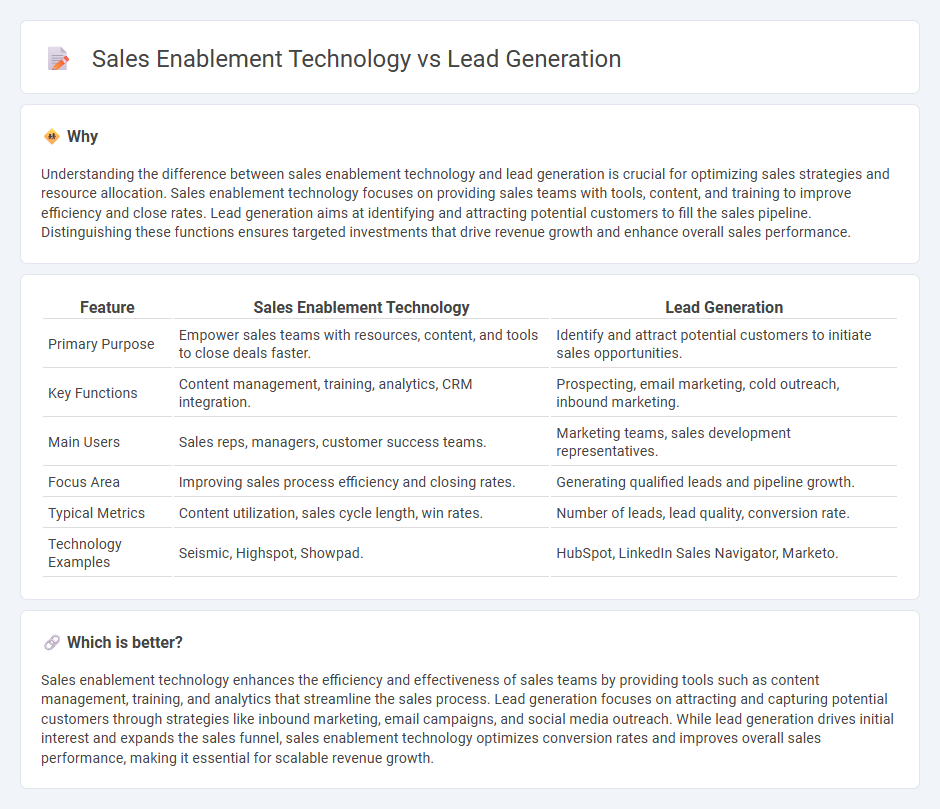
Sales enablement technology empowers sales teams by providing tools, content, and analytics to improve buyer engagement and accelerate deal closures, while lead generation focuses on identifying and attracting potential customers through targeted marketing efforts. Both strategies drive revenue growth but operate at different stages of the sales funnel, with enablement enhancing sales effectiveness and lead generation expanding the pipeline. Explore how integrating sales enablement technology with lead generation can maximize your sales performance.
Why it is important
Understanding the difference between sales enablement technology and lead generation is crucial for optimizing sales strategies and resource allocation. Sales enablement technology focuses on providing sales teams with tools, content, and training to improve efficiency and close rates. Lead generation aims at identifying and attracting potential customers to fill the sales pipeline. Distinguishing these functions ensures targeted investments that drive revenue growth and enhance overall sales performance.
Comparison Table
| Feature | Sales Enablement Technology | Lead Generation |
|---|---|---|
| Primary Purpose | Empower sales teams with resources, content, and tools to close deals faster. | Identify and attract potential customers to initiate sales opportunities. |
| Key Functions | Content management, training, analytics, CRM integration. | Prospecting, email marketing, cold outreach, inbound marketing. |
| Main Users | Sales reps, managers, customer success teams. | Marketing teams, sales development representatives. |
| Focus Area | Improving sales process efficiency and closing rates. | Generating qualified leads and pipeline growth. |
| Typical Metrics | Content utilization, sales cycle length, win rates. | Number of leads, lead quality, conversion rate. |
| Technology Examples | Seismic, Highspot, Showpad. | HubSpot, LinkedIn Sales Navigator, Marketo. |
Which is better?
Sales enablement technology enhances the efficiency and effectiveness of sales teams by providing tools such as content management, training, and analytics that streamline the sales process. Lead generation focuses on attracting and capturing potential customers through strategies like inbound marketing, email campaigns, and social media outreach. While lead generation drives initial interest and expands the sales funnel, sales enablement technology optimizes conversion rates and improves overall sales performance, making it essential for scalable revenue growth.
Connection
Sales enablement technology streamlines the lead generation process by providing tools such as CRM systems, content management, and analytics, which enhance communication and personalization with prospects. Integrating lead generation strategies within sales enablement platforms helps sales teams target high-quality leads more efficiently, increasing conversion rates. Data-driven insights from these technologies enable continuous optimization of campaigns and improve pipeline management for better sales outcomes.
Key Terms
Lead Generation:
Lead generation technology streamlines the process of identifying and capturing potential customers by utilizing AI-driven analytics, automated outreach, and CRM integrations to enhance lead quality and conversion rates. These tools prioritize data segmentation, real-time tracking, and predictive scoring to optimize marketing campaigns and increase ROI. Explore more about how cutting-edge lead generation technology can transform your customer acquisition strategy.
Prospecting
Lead generation technology focuses on identifying and capturing potential customer information to build a qualified prospect pipeline. Sales enablement technology equips sales teams with tools, content, and insights to engage prospects effectively and accelerate deal closure. Explore how integrating these technologies can transform your prospecting strategy and boost revenue growth.
Lead Scoring
Lead generation technology primarily targets identifying and capturing potential customers, while sales enablement technology equips sales teams with tools and content to close deals effectively. Lead scoring is a crucial feature within these systems, using algorithms to rank prospects based on their engagement, demographics, and likelihood to convert. Explore how advanced lead scoring methods can optimize your sales funnel and boost conversion rates.
Source and External Links
Lead Generation - Adobe Experience Cloud - Describes lead generation as the process of attracting and nurturing potential customers through various stages, including content creation and CRM engagement.
What is Lead Generation? Beginner's Guide for 2025 - Cognism - Explains lead generation as generating interest in a product or service and converting that interest into sales, detailing both inbound and outbound strategies.
What is Lead Generation? Guide & Best Practices | Salesforce US - Provides a comprehensive guide on lead generation, highlighting the importance of creating awareness and using targeted promotions to convert prospects into buyers.
 dowidth.com
dowidth.com